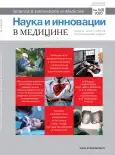Autologous mesenchymal stem cells in treatment of liver cirrhosis: evaluation of effectiveness and visualization method
- Authors: Kotkas I.E.1, Enukashvili N.I.1,2, Asadulayev S.M.1, Chubar A.V.2
-
Affiliations:
- North-Western State Medical University named after I.I. Mechnikov
- Institute of Cytology of the Russian Academy of Sciences
- Issue: Vol 5, No 3 (2020)
- Pages: 197-203
- Section: Surgery
- URL: https://journal-vniispk.ru/2500-1388/article/view/47377
- DOI: https://doi.org/10.35693/2500-1388-2020-5-3-197-203
- ID: 47377
Cite item
Full Text
Abstract
Through clinical observation, we present an assessment of the autologous mesenchymal stem cells effectiveness in treatment of liver cirrhosis of alimentary etiology. In order to determine the localization of the implanted cell structures, the stem cells were previously labeled with iron (II, III) oxide nanoparticles (IONPs). Further MRI visualization helped to detect the cell structures stained with iron oxide nanoparticles in the human body. In 6 months after the cell therapy, the patient underwent clinical and biochemical blood tests, MEGX test, elastography and subjective health assessment test. The tests data analysis revealed the improvement of the values of all examined parameters after the cell treatment. Also in 6 and 12 months after the treatment, a liver biopsy was performed from the area where the implanted stem cells were visualized. In histological examination of liver bioptates obtained from the area of MSC transplantation, the largest number of stained cells was observed in liver micronodes, as well as at the boundaries of micronodes and fibrous septa. A portion of the bioptate obtained in 12 months after transplantation was used to produce primary cell cultures. Before the first re-seeding of the cultures, cell colonies of both fibroblast-like morphology and epithelial were detected in them. Both types of colonies contained the particles.
Conducting the cell therapy to a patient with liver cirrhosis of alimentary etiology contributed to improving the laboratory and instrumental examinations indicators. The patient had come through the treatment procedure satisfactorily, no complications were registered.
Full Text
##article.viewOnOriginalSite##About the authors
Inna E. Kotkas
North-Western State Medical University named after I.I. Mechnikov
Author for correspondence.
Email: inna.kotkas@yandex.ru
ORCID iD: 0000-0003-4605-9887
PhD, Associate Professor, Department of Faculty surgery named after I.I. Grekov, Head of the Department of surgery in the E.E. Eichwald clinic
Russian Federation, Saint PetersburgNatella I. Enukashvili
North-Western State Medical University named after I.I. Mechnikov; Institute of Cytology of the Russian Academy of Sciences
Email: inna.kotkas@yandex.ru
ORCID iD: 0000-0002-5971-7917
PhD, Biology, senior researcher
Russian Federation, Saint PetersburgShamil M. Asadulayev
North-Western State Medical University named after I.I. Mechnikov
Email: inna.kotkas@yandex.ru
ORCID iD: 0000-0002-1915-1250
PhD, surgeon of the x-ray endovascular office
Russian Federation, Saint PetersburgAnna V. Chubar
Institute of Cytology of the Russian Academy of Sciences
Email: inna.kotkas@yandex.ru
ORCID iD: 0000-0002-4160-1385
junior research associate of the Laboratory of non-coding DNA
Russian Federation, Saint PetersburgReferences
- Enukashvili NI, Kotkas IE, Bogolyubov DS, et al. Detection of cells containing internalized multi-domain magnetic iron oxide (II, III) nanoparticles by MRI. Zhurnal tekhnicheskoj fiziki. 2020;90(9):1418–1427. (In Russ.). [Енукашвили Н.И., Коткас И.Е., Боголюбов Д.С. и др. Детекция клеток, содержащих интернализованные мультидоменные магнитные наночастицы оксида железа (II, III), методом МРТ. Журнал технической физики. 2020;90(9):1418–1427.
- Belyakin SA, Bobrov AN. Mortality from cirrhosis of the liver as an indicator of the level of alcohol consumption in the population. Vestnik Rossijskoj voenno-medicinskoj akademii. 2009;3:189–194. (In Russ.). [Белякин С.А., Бобров А.Н. Смертность от цирроза печени как индикатор уровня потребления алкоголя в популяции. Вестник Российской военно-медицинской академии. 2009;3:189–194].
- Kaliaskarova KS, Bajmagambetova ZhB, et al. Modern aspects of pathogenesis of viral liver fibrosis. The Journal of Clinical Medicine of Kazakhstan. 2012;2(25):89–92. (In Russ.). [Калиаскарова К.С., Баймагамбетова Ж.Б. и др. Современные аспекты патогенеза вирусного фиброза печени. Клиническая медицина Казахстана. 2012;2(25):89–92].
- Pogranc I, Dobrivojević Radmilović M, Ahmed L, et al. D-mannose-Coating of Maghemite Nanoparticles Improved Labeling of Neural Stem Cells and Allowed Their Visualization by ex vivo MRI after Transplantation in the Mouse Brain. Cell Transplantation. 2019;28(5):553–567. doi: 10.1177/0963689719834304
- Dominici M, Le Blanc K, Mueller I, et al. Minimal criteria for defining multipotent mesenchymal stromal cells. The International Society for Cellular Therapy position statement. Cytotherapy. 2006;8(4):315–317. doi: 10.1080/14653240600855905
- Snykers S, De Kock J, Vanhaecke T, Rogiers V. Hepatic Differentiation of Mesenchymal Stem Cells: In Vitro Strategies. Mesenchymal Stem Cell Assays and Applications, Methods in Molecular Biology. 2011;698:305–314. doi: 10.1007/978-1-60761-999-4_23
- Stock P, Brückner S, Ebensing S, et al. The generation of hepatocytes from mesenchymal stem cells and engraftment into murine liver. Nat Protoc. 2010;5:617–627. doi.org/10.1038/nprot.2010.7
- Kholodenko IV, Kurbatov LK, Kholodenko RV, et al. Mesenchymal Stem Cells in the Adult Human Liver: Hype or Hope? Cells. 2019;8(10):1127. doi: 10.3390/cells8101127
- Frangioni JV, Hajjar RJ. In vivo tracking of stem cells for clinical trials in cardiovascular disease. Circulation. 2004;110(21):3378–3383. doi.org/10.1161/01.cir.0000149840.46523.fc
- Tong l, Zhao H, He Z, li Z. Current perspectives on molecular imaging for tracking stem cell therapy. In: Medical imaging in clinical practice. In Tech. 2013;73–79. doi.org/10.5772/53028
- Chen ZY, Wang Y-X, Yang F, et al. New researches and application progress of commonly used optical molecular imaging technology. Biomed Res Int. 2014:429198. doi.org/10.1155/2014/429198
- Meleshina AV, Cherkasova EI, Shirmanova MV, et al. Modern methods of stem cell imaging in vivo (review). Sovrem. tekhnol. med. 2015;4. (In Russ.). [Мелешина А.В., Черкасова Е.И., Ширманова М.В. и др. Современные методы визуализаци стволовых клеток in vivo (обзор). Современные технологии медицины. 2015;4]. URL: https://cyberleninka.ru/article/n/sovremennye-metody-vizualizatsi-stvolovyh-kletok-in-vivo-obzor
Supplementary files










